Dromons in defense of Constantinople
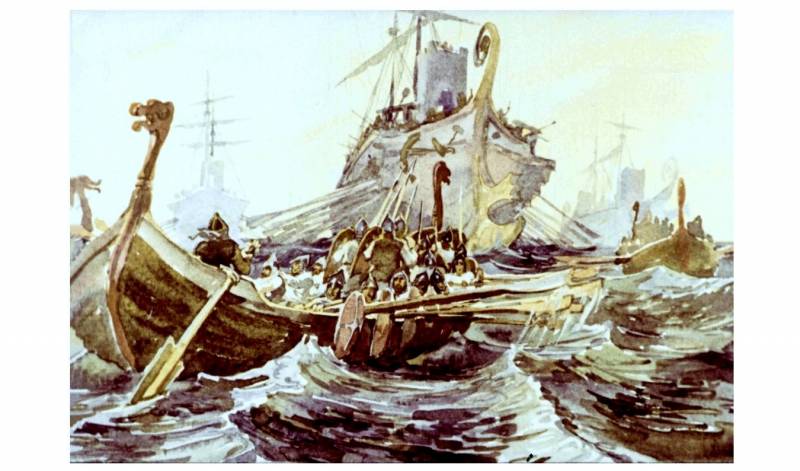
The battle of the Russians with the dromon. Artist D. Pashkov
This article continues a series of articles on the sieges of the capital of Byzantium - Constantinople.
It will focus on the most important mechanism for dealing with the besiegers - about navy. Since the sea washed the capital of the Roman Empire from three sides, not only was the threat to the city often stopped by the fact that the fleet struck at the besiegers, but the besiegers themselves used ships to fight the capital.
In my articles, I have already talked about the sieges in the period from the founding of the city to the tenth century inclusive. In each of these periods, the fleet contributed to the fight against the besiegers. But also on different historical stages, especially since the emergence and formation of the Eastern Roman Empire with its capital in Constantinople, the military fleet has undergone a number of changes and transformations.
The strengthening of the power and strength of the fleet occurred from the end of the XNUMXth century, the Roman fleet dominated the Mediterranean, especially in its eastern part during the XNUMXth - early second half of the XNUMXth century.
And as Kekavmen wrote in "Advice to Vasileus":
Siege of Constantinople and fleet
When the committee of the federates Vitalian raised an uprising, in 516 he sent a Danube flotilla of 200 ships with a landing force and captured the harbor on the Thracian coast of the Bosporus, 11 km from the capital. But other rebels against the emperor Phocas managed to take the capital on October 5, 610 by the forces of the fleet, which was headed by the future emperor Heraclius.
And sixteen years later, the Byzantine fleet saved the empire from a double siege, from the troops of the Sasanian Iran and the Avars, preventing them from connecting. In the Golden Horn, the fleet defeated a flotilla of Slavic one-trees, which, by order of the Avar Khagan, were to land at the walls of Blachernae.
But, if before the capture of the eastern part of the empire of the Romans by the Arabs, the Byzantines had undivided dominance at sea, which was practically not threatened by anyone, then after the Arabs, using the human and technical resources of Egypt and Lebanon, they built their navy.
Many researchers claim that the Arabs created ships based on their experience of sailing around Arabia and merchant trips to Iran and India. But their knowledge by this time in navigation, in comparison with the Romans, was minimal. And they successfully took advantage of someone else's experience. Even the naval infrastructure that they inherited from the Romans, they simply renovated at first, and only later began to make changes and innovations, as when polishing the mirror of the famous lighthouse in Alexandria, with which they allegedly could burn Byzantine ships.
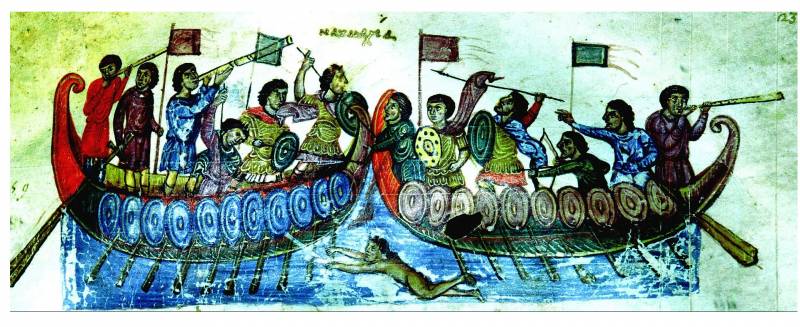
Dromon battle. Pseulo-Oppian. Kinegetics code. Constantinople. XNUMXth century Marchian Library. Venice
The dromon was taken as the basis of the warship. The first innovation that the Arabs introduced, as is often written in the literature, was the protection of the upper deck. With which it is difficult to agree. Here is what Procopius of Caesarea wrote about the campaign of the Roman fleet against the vandals in Libya:
The further conquest of the Mediterranean coast led to the fact that more and more inhabitants of the coast, experienced sailors, joined the ranks of the Arab fleet, who created, of course, under the leadership of Arab commanders, pirate fleets that for centuries inspired fear in the Christian world.
But during the two sieges of Constantinople, the fleet was able to inflict a sensitive defeat on the Arabs in 673-677. and in 716-718. After such activity of the Arab fleet, the Romans began to pay increased attention to the development of the fleet, although this was not always possible. The fleet had to operate away from the capital, fighting numerous pirate fleets from Africa and even from Spain. The fleet was engaged in the transfer of contingents to the western themes of the empire. And with the advent of the “Ros”-Russian fleets near Constantinople, the work increased.
Nevertheless, until the 70s of the XI century, the fleet succeeded in this successfully. The importance of the fleet for the defense of the capital was also understood by enemies, such as the Bulgarian Tsar Simeon the Great. He sent an embassy to Egypt in 923 to draw the Arab fleet into the siege of Constantinople.
How was the fleet of the empire completed at that time?
marine theme
Theme structure from the XNUMXth to XNUMXth centuries was formed on the basis of a territorial community. And the main warrior was a warrior-peasant, a stratiot. They carried out a "stratum", i.e. military service, and had a "stratum" - a land plot from which the service was carried out, later the owner could pay epirius from this plot, so as not to serve himself. The transition to Epirius took place from the end of the XNUMXth century to the second half of the XNUMXth century. The same strata (only "sea strata") were among the sailors, that is, the inhabitants of the coastal territories of marine themes: this is the theme of the Kivirreots, a territory at the tip of the southwest of Asia Minor, about. Samos and the islands of the Aegean Sea.
According to the short story of Constantine VII, the maritime stratum was equal to the land stratum in the amount of four liters per liter, while the strata of the imperial fleet were equal to two liters. The fact is that the stratiots of the marine themes themselves fully equipped the ships, and the stratiots of the basileus fleet served on ships prepared by the state.
Ibn-Khaukal reported that in all sea villages there was a collection from the “smoke” (hearth) of one denarius, rather, one nomisme. Then the sailors are given 12 coins each, the rest of the money is taken by the “sea prefect”, the drungari, and after the campaign he uses it according to his own understanding. Food is given to the sailors from the drungaria or “what God sends and the basileus will grant”, and all the wealth captured on the campaign and the ransom from the prisoners are transferred to the emperor.
Thus, it was the responsibility of the seaside themes to equip the thethemic fleet with ships, warriors, and oarsmen.
Rowers were formed into certain detachments, which were called "ousia" or "uziakos", they consisted of 108 or 110 rowers, which formed the crews of dromons or helands. Often these warriors were on ships as amphibious assault or marines, in modern terms.
Thus, stratiotes from marine themes served as warriors on ships, as well as sailors and rowers. During the collapse of the theme system in the XNUMXth century, stratiots preferred to serve as rowers so as not to spend money on weapons.
Armament of sailors
Emperor Leo VI the Wise (r. 886–912), about whom I already wrote in the article “How Byzantium Almost Became an Empire of the Slavs and Greeks,” wrote Tactics. The article in this "Tactics", devoted to naval military affairs, unlike many other articles, is of an independent nature. Here is what the emperor writes about the weapons that the sailors were supposed to have:
Let's dwell on some of the types of weapons listed.
Leo VI described defensive armament as follows:
Likewise, Nikephoros II Phocas (r. 963-969) considers zabu to be part of the cleavage, that is, it is a protective type of weapon, lamenar or lamellar, judging by the images that have survived to this day. Contrary to the assertion of researchers (J. Dennnison), that this is chain mail (coat of mail). This is confirmed by Leo the Deacon, who emphasizes the armament of the Russians of Svyatoslav, “a torus made of movable joints” (άλυσἰδοτος θώραξ) - chain mail, in contrast to the armament of the Romans. Thus, the "marines" had to be in cleavage or cleavage, plate or scale armor.
But the “neurik” is a very interesting equipment, which is defined as a protective jacket made of a double layer of felt, this type of equipment is found a lot in the military literature of this period, most likely, this protection is much shorter than the cavadium, “made of felt and leather”, because on deck he would have hampered the movements of a warrior.
I would also like to dwell on such a type of weapon as menavla or monavlata, from the distorted Latin name of the hunting spear - venabulus. This weapon, according to Nicephorus Uranus, was 2,7–3,7 m long. Monavlata or menavla under Emperor Nicephorus II Fok was a heavy spear of an infantry unit that stopped the heavily armed Arab cavalry.
And Leo VI pointed out that it should be used in naval combat, its peculiarity was striking from the lower tier of oars at the ship and sailors of the enemy. It was not excluded and its throwing towards the enemies.
And what actually happened with the weapons of the sailors, not on the pages of Tactics, but in life? First of all, all hand-held throwing devices were used, of course, bows and such exotic things, as we saw above - heavy shells.
Sailors from two personal imperial helands, when the emperor sent them to war with the rest of the fleet, were supplied with shields, spears, the best helmets and all the necessary weapons. And as the author of Naumachiai Sirian Magister wrote, stratiots in the fleet should be armed like the first row of ground units, i.e., be fully equipped with protective weapons.
Seamen training
Initially, all sailors in the fleet were people from areas of intensive navigation, so to speak, natural sailors and rowers. For example, from Egypt. They were the basis of the commands of the Byzantine fleet during the period of the conquests of Justinian the Great, they also formed the basis of the Arab fleet after the conquest of Roman Egypt by the Saracens. The same can be said about the inhabitants of other seaside themes. The fleet of the Romans lost its importance with the capture of coastal themes and islands by Byzantium by the 90s of the XNUMXth century: there are no sailors, there is no coastal infrastructure, and there is no fleet.
Particular attention was paid to the training of rowers, they had to be able not only to row to the beat at the command of the helmsman, but also to swim and dive.
Each team had to have sailors responsible for the survivability of the ship. In the event of a hole, they had to be able to repair it with improvised means, before help arrived. All the stratiotes who fight on the upper deck, notes the emperor Leo, had to be strong and courageous, especially those who fight hand-to-hand.
Weak warriors should be sent to the lower tier. But Sirian the Magister writes about scout sailors who land on land and were supposed to be swift and vigilant, armed only with daggers.
Emperor Leo requires constant training of soldiers, both in hand-to-hand combat, and in the work of managing the ship, and in actions in the ranks.
The commanders of warships were, as Vasilevs Leo writes, in the imperial fleet - archons, and on thematic ships - drungaria and turmarchs. Above several imperial ships stood a commander, who was called an archon or comite, and above the thematic three or five dromons, a strategos. Later they were called Komites-Drungarii. How to manage a strategist with a detachment of ships, both Sirian the Magister and Leo VI wrote.
At the head of the imperial fleet was the drungari of the fleet, which from the XNUMXth century was called the "catepan of the fleet" or "duka of the fleet". Emperor Romanus Lakapis was a drungar of the fleet before, as Constantine the Bogryanogenny wrote, “entered the palace and found himself, I don’t know how to put it, the owner of the kingdom.”
At the head of the thematic fleets were the thematic leaders: the stratigi or duks of the themes. They were accompanied by "protonotaries", civilians, not military persons, who were in charge of finances and naval property.
The commanders were supposed to be "pilots", people who knew well the peculiarities of navigation in a particular area, reefs and shallows, the wind rose. There is a lot of evidence about how the fleet, caught in a storm, was either completely destroyed, or its ships were scattered over long distances. Therefore, knowledge of the wind rose was an important condition prescribed in Tactics. The fleet of the Romans fought not only at oars, but also under sail. Under such conditions, in the same Sirian Magister we read:
Based on practice, often the fleet did not move in formation, but at random, which made it possible for the enemy to destroy the dromons one by one, so the Tactics required to observe the formation. The same requirements were for the formation in battle, since it happened that the ships entered the battle as they arrived at the battlefield, and not lined up in a certain order.
We know about several types of formation in battle, as well as different arrangements of ships, depending on their size: the largest dromons could be located either in the center of the formation or along the flanks. The formations were carried out in a crescent or semicircle, with the aim of covering the flanks, in one or two lines or in separate detachments, depending on the situation. It was necessary to use the features of the terrain, for example, to wage a battle between two islands, to carry out a feigned flight. All these tactics were used later, in the same fleets of the Italian republics.
Dromon
The main combat unit throughout the entire period of the existence of the Roman fleet was the dromon. It was both the name, in fact, of the ship, and the generic definition for warships.
There is a lot of controversy surrounding the names of Byzantine ships. We emphasize that our main knowledge comes from written sources, and they do not allow us to speak unambiguously about Byzantine ships and dromons, in particular. There can be many guesses and assumptions, most of them have the right to exist, but in history as a science, a hypothesis is not a key research method.
It is only clear that the dromon originates from the ships of the previous Greco-Roman period.
Dromons were large and small, some were used to fight the Arabs, who had similar ships, but small ones - against, for example, the Ross. And they were used on the rivers for landing. There were dromons that could carry horses.
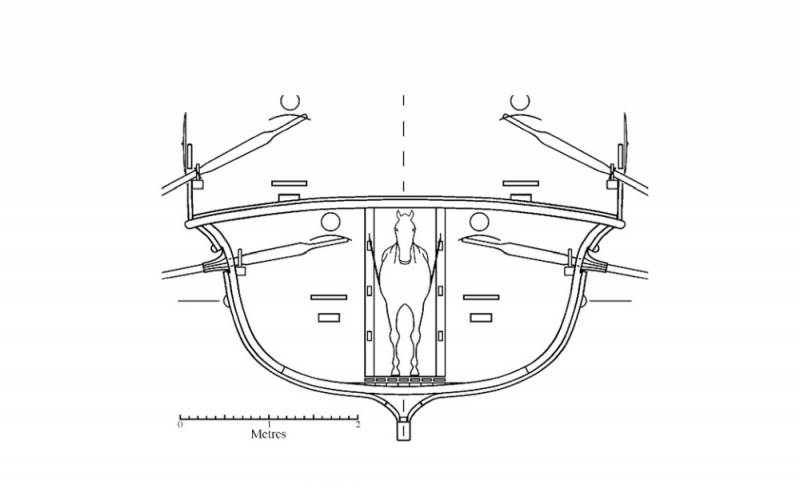
Scheme-reconstruction. How horses were transported on dromon or helandia. As Emperor Leo wrote: “to equip ships carrying cargo and horses, as if playing the role of a convoy.” Source: John H. Pryor, E. M. Jeffreys. The age of DROMΩN The Byzantine Navy ca 500–1204. Leiden-Boston. 2006
Since the XNUMXth century, ships have had a new name - helandia. Helandia (judging by the fact that Constantine Porphyrogenitus described two imperial helandia) was the same dromon, but more elegant and richly decorated. Then the authors, depending on taste, used one or the other name, as well as a later name - "galley", which, again, was artificially formed. Most likely, the dromon began to be called a galley in a later historical period.
Let's not forget that a number of future maritime republics, such as Venice and Amalfi, for a long time - until the middle of the XNUMXth century, were cities subordinate to Byzantium, and their fleets were formed within the framework of the Roman Empire.
Here is how Emperor Leo VI describes the “model” dromon:
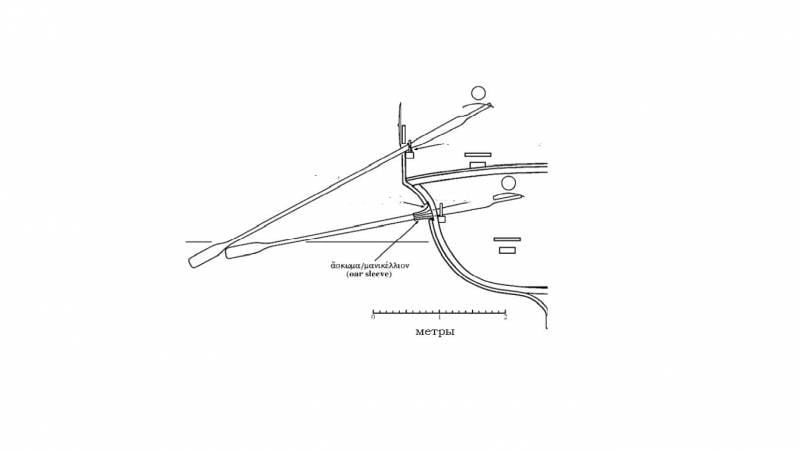
This diagram shows the arrangement of the rowers on the dromon. Source: John H. Pryor, E. M. Jeffreys. The age of DROMΩN The Byzantine Navy ca 500–1204. Leiden-Boston. 2006
Given the strict succession of Byzantium from the Roman Empire, which has been repeatedly observed with other military institutions and terms, it can be argued that the dromon was the successor of the liburnum.
As Vegetius, an author of the early fifth century, wrote:
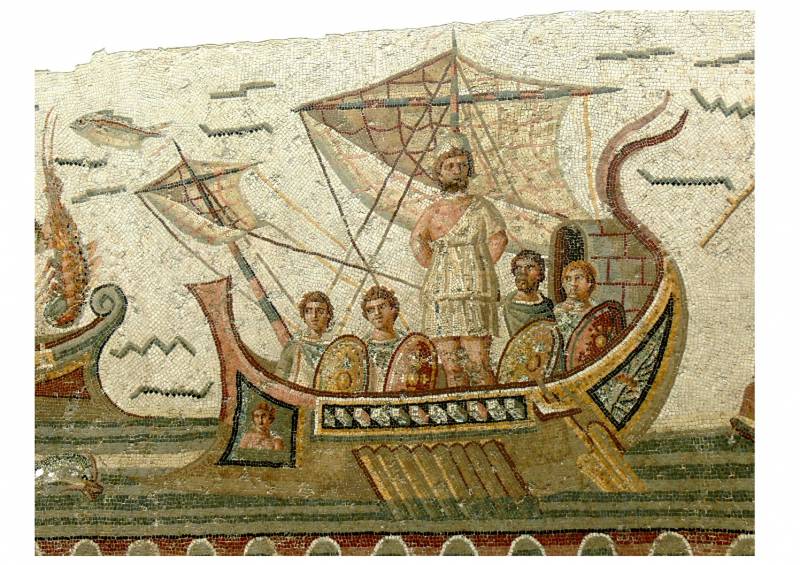
Odysseus on a ship. Mosaic. XNUMXrd century Carthage. Museum of Bordeaux. Tunisia. Author's photo
Vegetius objects to those who would be surprised, where did such ships with four and five rows of oars come from among the Romans at this time? Indeed, we practically do not meet them either in the late Roman period, and even in the period of Byzantium: there was no need for such ships.
We see new three-row ships in large numbers only in the XNUMXth century, as both Nikita Khonian and Anna Komnenos wrote about.
If there was one row of oars on the dromon, then its length should have been fifty or sixty meters, if in two rows - forty meters. The width of the dromons was about 4,5 meters, the draft was a little more than a meter, and the displacement was about 100 tons.
The lower row of oars was protected from water by leather cuffs, similar to non-return valves and protected from water and friction. The oars of the upper row were guided by pegs. All oars were fastened with belt loops (zevglas), which also kept the oar from falling if the rower was killed. In the bottom row, rowers worked blindly, flutists set the pace since the time of the ancient Greeks.
In practice, most likely, dromons were of different sizes, and single-row dromons, in all likelihood, were the vast majority, but outstanding ships attracted special attention. Small dromons could be called "moners" or galleys.
Titmar of Mirzenburg describes such a fire-bearing dromon,
This ship took hostage the Emperor Otto II himself:
The ships had names. So, the imperial dromons or helandias were called "Dromon of Basileus" and "Follower".
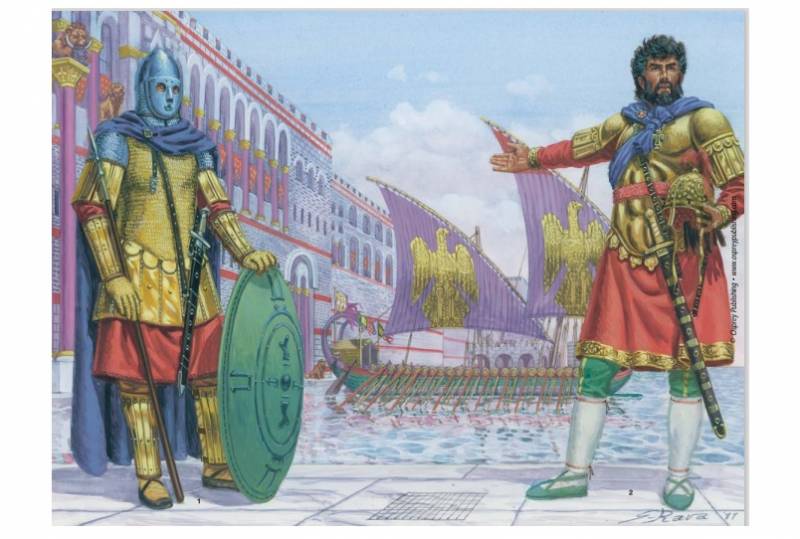
Imperial drone. Osprey Publishing. Hood. Giuseppe Rava
If we exclude the richly decorated helandia of the emperor, then we have a number of other types of sea vessels - for example, pleasure farmers, but the dromon remains the key one.
Dromon armament
There is an ongoing dispute around the dromons, whether they all had “Greek fire” on board or were “fire-bearing” dromons and without “Greek fire” siphons. We will devote a separate story to this issue.
How did the dromon defend itself? And what weapon did he have?
The dromon had a powerful ram, it was installed exactly along the waterline and could also be used as a boarding bridge.
During this period, control over the ship's draft was an important issue. In the battle with the Sicilians of King Roger, the Venetians did not control such a situation when their dromons used up all their weapons, floated on the surface of the water, which did not even reach the second lane. And so, when all the soldiers crowded around the sides facing the enemy, the ships sank.
On large dromons on the deck, xylocastrons were built, towers made of wood, in the Roman period they were built of brick. The towers were covered with leather.
At the stern, bow and sides of the dromons, toxobolists were to be installed, which throw small arrows, “flies”.
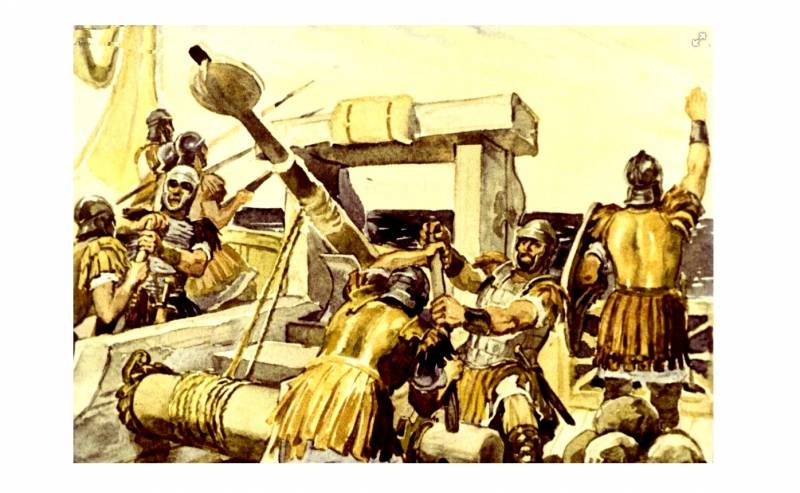
On the deck of the dromon. Artist D. Pashkov
Various throwing weapons were used, of course, only those that could fit on the deck. With their help, before landing, they cleared the coast from enemy troops. On board there could be a device called a “crane”, an angular structure that could rotate around its axis and had a chute through which liquid hot resin could be poured onto an enemy ship.
Millstones, triboles, pots of fire, wooden pieces with driven nails, wrapped in tow, which were thrown on fire, were thrown from the ship. And even such exotic as pots with snakes. There is always a question about fire safety on the ship. Little is said about this in Tactics.
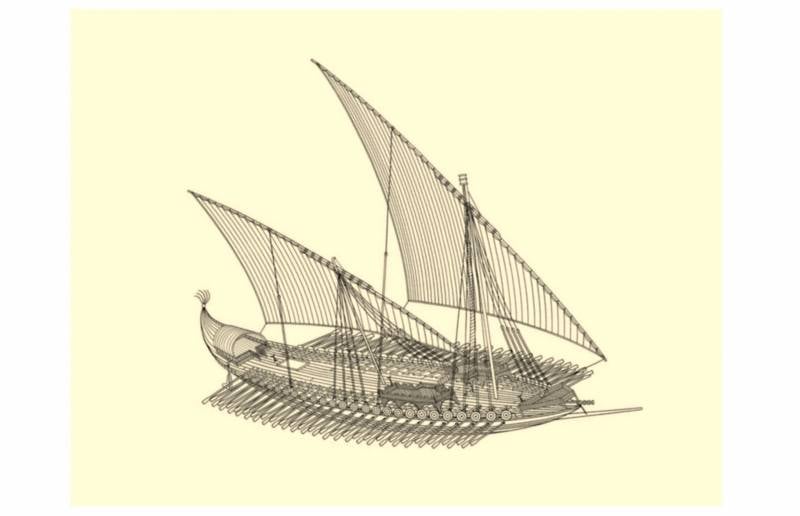
Dromon. Reconstruction by J. Prior. Source: John H. Pryor, E. M. Jeffreys. The age of DROMΩN The Byzantine Navy ca 500–1204. Leiden-Boston. 2006
Thus, the Byzantine fleet, consisting of dromons, was used both to move troops and to participate in naval battles. The fleet reached the peak of its development at the end of the XNUMXth - beginning of the XNUMXth centuries. This is what the fleet was like during this period. Leo the Deacon describes the expedition against Cyprus, captured by the Arabs:
And as Kekavmen prophetically said: while there was a fleet, both Byzantium and its capital Constantinople existed.
To be continued ...
Information